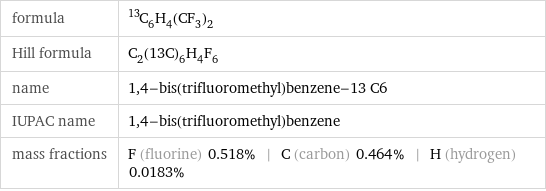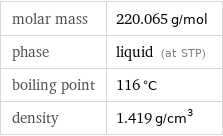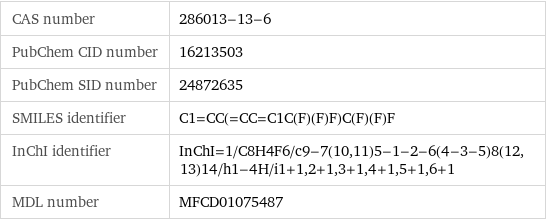Input interpretation

1, 4-bis(trifluoromethyl)benzene-13 C6
Chemical names and formulas

formula | ^13C_6H_4(CF_3)_2 Hill formula | C_2(13C)_6H_4F_6 name | 1, 4-bis(trifluoromethyl)benzene-13 C6 IUPAC name | 1, 4-bis(trifluoromethyl)benzene mass fractions | F (fluorine) 0.518% | C (carbon) 0.464% | H (hydrogen) 0.0183%
Lewis structure

Draw the Lewis structure of 1, 4-bis(trifluoromethyl)benzene-13 C6. Start by drawing the overall structure of the molecule, ignoring potential double and triple bonds: Count the total valence electrons of the carbon (n_C, val = 4), fluorine (n_F, val = 7), and hydrogen (n_H, val = 1) atoms: 8 n_C, val + 6 n_F, val + 4 n_H, val = 78 Calculate the number of electrons needed to completely fill the valence shells for carbon (n_C, full = 8), fluorine (n_F, full = 8), and hydrogen (n_H, full = 2): 8 n_C, full + 6 n_F, full + 4 n_H, full = 120 Subtracting these two numbers shows that 120 - 78 = 42 bonding electrons are needed. Each bond has two electrons, so in addition to the 18 bonds already present in the diagram add 3 bonds. To minimize formal charge carbon wants 4 bonds. Identify the atoms that want additional bonds and the number of electrons remaining on each atom: Fill in the 3 bonds by pairing electrons between adjacent highlighted atoms. Note that the six atom ring is aromatic, so that the single and double bonds may be rearranged: Answer: | |
Basic properties

molar mass | 220.065 g/mol phase | liquid (at STP) boiling point | 116 °C density | 1.419 g/cm^3
Units

Liquid properties (at STP)

density | 1.419 g/cm^3 refractive index | 1.379
Units

Non-standard atom properties

C-13 | 6
Chemical identifiers

CAS number | 286013-13-6 PubChem CID number | 16213503 PubChem SID number | 24872635 SMILES identifier | C1=CC(=CC=C1C(F)(F)F)C(F)(F)F InChI identifier | InChI=1/C8H4F6/c9-7(10, 11)5-1-2-6(4-3-5)8(12, 13)14/h1-4H/i1+1, 2+1, 3+1, 4+1, 5+1, 6+1 MDL number | MFCD01075487
Safety properties

flash point | 21.67 °C